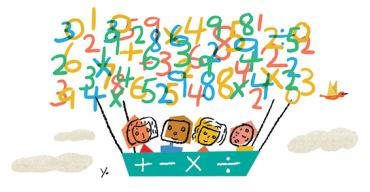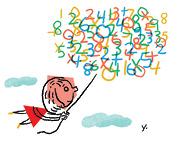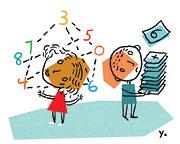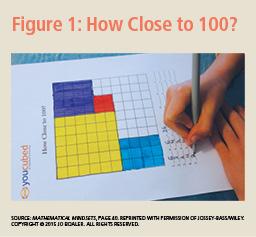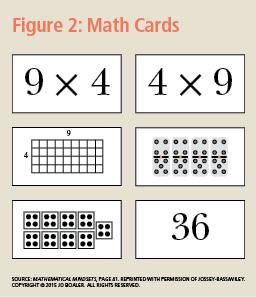Babies and infants love mathematics. Give babies a set of blocks, and they will build and order them, fascinated by the ways the edges line up. Children will look up at the sky and be delighted by the V formations in which birds fly. Count a set of objects with a young child and then move the objects and count them again, and they will be enchanted by the fact they still have the same number. Ask children to make patterns with colored blocks, and they will work happily making repeating patterns—one of the most mathematical of all acts. Mathematician Keith Devlin has written a range of books showing strong evidence that we are all natural mathematics users and thinkers.1 We want to see patterns in the world and to understand the rhythms of the universe. But the joy and fascination young children experience with mathematics are quickly replaced by dread and dislike when they start school mathematics and are introduced to a dry set of methods they think they just have to accept and remember.
In Finland, one of the highest-scoring countries in the world on PISA (Program for International Student Assessment) tests, students do not learn formal mathematics methods until they are 7 years old. In the United States, students start much earlier, and by the time they are 7, they have already been introduced to algorithms for adding, subtracting, multiplying, and dividing numbers, and been made to memorize multiplication facts. For many students, their first experience of math is one of confusion, as the methods do not make sense to them. The inquisitiveness of our children’s early years fades away and is replaced by a strong belief that math is all about following instructions and rules.
The best and most important start we can give our students is to encourage them to play with numbers and shapes, thinking about what patterns and ideas they can see. In her autobiography, Sarah Flannery, who won Europe’s Young Scientist of the Year Award in 1999 for inventing a new mathematical algorithm, talks about the way she developed her mathematical thinking from working on puzzles at home with her dad, and how these puzzles were more important to her than all of her years of math class.2
Successful math users have an approach to math as well as mathematical understanding that sets them apart from less successful users. They approach math with the desire to understand it and to think about it, and with the confidence that they can make sense of it. Successful math users search for patterns and relationships and think about connections. They approach math with a mathematical mindset, knowing that math is a subject of growth and that their role is to learn and think about new ideas. We need to instill this mathematical mindset in students from their first experiences of math.
Research has shown definitively the importance of a growth mindset—the belief that intelligence grows and that the more you learn, the more mathematical pathways you develop. But to erase math failure, we need students to have growth beliefs about themselves and accompany them with growth beliefs about the nature of mathematics and their role in relation to it. Children need to see math as a conceptual, growth subject that they should think about and make sense of.
When students see math as a series of short questions, they cannot see the role for their own inner growth and learning. They think that math is a fixed set of methods that either they get or they don’t. But when students see math as a broad landscape of unexplored puzzles in which they can wander around, asking questions and thinking about relationships, they understand that their role is thinking, sense making, and growing. When students see mathematics as a set of ideas and relationships, and their role as one of thinking about the ideas and making sense of them, they have a mathematical mindset.
So how do we develop mathematical mindsets in students so that they are willing to approach math with sense making and intuition? Before they start school, the task is straightforward. It means asking children to play with puzzles, shapes, and numbers and think about their relationships.
But in the early years of school, we live in a system whereby students are required, from an early age, to learn many formal mathematical methods, such as those used to add, subtract, divide, and multiply numbers. This is the time when students stray from mathematical mindsets and develop fixed, procedural mindsets. This is the time when it is most critical that teachers and parents introduce mathematics as a flexible conceptual subject that is all about thinking and sense making. The domain of early number work gives us the perfect example of the two mindsets that can develop in students, one that is negative and leads to failure and one that is positive and leads to success.
Number Sense
In an important research study, two British researchers worked with students, ages 7 to 13, who had been nominated by their teachers as being either low, middle, or high achieving.3 All of the students were given number problems, such as adding or subtracting two numbers. The researchers found an important difference between the low- and high-achieving students. The high-achieving students solved the questions by using what is known as number sense—they interacted with the numbers flexibly and conceptually. The low-achieving students used no number sense and seemed to believe that their role was to recall and use a standard method, even when this was difficult to do.
For example, when students were given a problem such as 21−6, the high-achieving students made the problem easier by changing it to 20−5, but the low-achieving students counted backward, starting at 21 and counting down, which is difficult to do and prone to error. After extensive study of the different strategies that the students used, the researchers concluded that the difference between the high- and low-achieving students was not that the low-achieving students knew less mathematics, but that they were interacting with mathematics differently. Instead of approaching numbers with flexibility and number sense, they seemed to cling to formal procedures they had learned, using them very precisely, not abandoning them even when it made sense to do so. The low achievers did not know less, they just did not use numbers flexibly—probably because they had been set on the wrong pathway, from an early age, of trying to memorize methods and number facts instead of interacting with numbers flexibly.4
The researchers pointed out something else important—the mathematics the low achievers were using was a harder mathematics. It is much easier to subtract 5 from 20 than to start at 21 and count down 6 numbers. Unfortunately for low achievers, they are often identified as struggling with math and therefore given more drill and practice—cementing their beliefs that math success means memorizing methods, not understanding and making sense of situations. They are sent down a damaging pathway that makes them cling to formal procedures, and as a result, they often face a lifetime of difficulty with mathematics.
A mathematical mindset reflects an active approach to mathematics knowledge, in which students see their role as understanding and sense making. Number sense reflects a deep understanding of mathematics, but it comes about through a mathematical mindset that is focused on making sense of numbers and quantities. It is useful to think about the ways number sense is developed in students, not only because number sense is the foundation for all higher-level mathematics5 but also because number sense and mathematical mindsets develop together, and learning about ways to develop one helps the development of the other.
Mathematics is a conceptual domain. It is not, as many people think, a list of facts and methods to be remembered. When students learn to count, they remember order and names for numbers, but they also develop the concept of number; that is, the idea of a number. In the early stages of learning to add numbers, students learn a method called “counting on.” Counting on is used when you have two sets of numbers—for example, 15 plus 4—and you learn to count the first set (counting to 15), then continue counting (16, 17, 18, 19). When students learn the method of counting on, they develop the concept of “sum.” This is not a method of addition; it is a conceptual idea.
In the next stage of their mathematics work, students may learn to add groups of numbers, such as three groups of 4, and as they learn to add groups, they develop the concept of a product. Again, this is not a method (of multiplication); it is a conceptual idea. The ideas of a number, a sum, and a product are concepts in mathematics that students need to think deeply about. Students should learn methods, such as adding and multiplying, not as ends in themselves but as part of a conceptual understanding of numbers, sums, and products and how they relate to each other.
We know that when we learn mathematics, we engage in a brain process called “compression.” When you learn a new area of mathematics that you know nothing about, it takes up a large space in your brain, as you need to think hard about how it works and how the ideas relate to other ideas. But the mathematics you have learned before and know well, such as addition, takes up a small, compact space in your brain. You can use it easily without thinking about it. The process of compression happens because the brain is a highly complex organ with many things to control, and it can focus on only a few uncompressed ideas at any one time. Ideas that are known well are compressed and filed away. William Thurston, a top mathematician who won the Fields Medal, describes compression like this:
Mathematics is amazingly compressible: you may struggle a long time, step by step, to work through the same process or idea from several approaches. But once you really understand it and have the mental perspective to see it as a whole, there is often a tremendous mental compression. You can file it away, recall it quickly and completely when you need it, and use it as just one step in some other mental process. The insight that goes with this compression is one of the real joys of mathematics.6
Many students do not describe mathematics as a “real joy”—in part because they are not engaging in compression. Notably, the brain can only compress concepts; it cannot compress rules and methods. Therefore, students who do not engage in conceptual thinking, and instead approach mathematics as a list of rules to remember, are not engaging in the critical process of compression, so their brain is unable to organize and file away ideas; instead, it struggles to hold onto long lists of methods and rules. This is why it is so important to help students approach mathematics conceptually at all times. Approaching mathematics conceptually is the essence of what I describe as a mathematical mindset.
What about Math Facts?
Many people believe that it is not possible to think conceptually about mathematics all the time because there are lots of math facts (such as 8 x 4 = 32) that have to be memorized. There are some math facts that are good to remember, but students can learn math facts and commit them to memory through conceptual engagement with math. Unfortunately, some teachers and parents think that because some areas of mathematics are factual, such as number facts, they need to be learned through mindless practice and speed drills. It is this approach to early learning about numbers that causes damage to students, makes them think that being successful at math is about recalling facts at speed, and pushes them onto a procedural pathway that works against their development of a mathematical mindset.
Math facts by themselves are a small part of mathematics, and they are best learned through the use of numbers in different ways and situations. Unfortunately, many classrooms focus on math facts in isolation, giving students the impression that math facts are the essence of mathematics, and, even worse, that mastering the fast recall of math facts is what it means to be a strong mathematics student. Both of these ideas are wrong, and it is critical that we remove them from classrooms, as they play a key role in creating math-anxious and disaffected students.
I grew up in a progressive era in England, when primary schools focused on the “whole child,” and I was not presented with tables of addition, subtraction, or multiplication facts to memorize in school. I have never committed math facts to memory, although I can quickly produce any math fact, as I have number sense and I have learned good ways to think about number combinations. My lack of memorization has never held me back at any time or place in my life, even though I am a mathematics professor, because I have number sense, which is much more important for students to learn and includes the learning of math facts along with a deep understanding of numbers and the ways they relate to each other.
For about one-third of students, the onset of timed testing is the beginning of math anxiety.7* Cognitive scientist Sian Beilock and her colleagues have studied people’s brains through MRI imaging and found that math facts are held in the working memory section of the brain. But when students are stressed, such as when they are answering math questions under time pressure, the working memory is compromised, and students cannot access the math facts they know.8 As students realize they cannot perform well on timed tests, they start to develop anxiety, and their mathematical confidence erodes. The blocking of the working memory and associated anxiety is particularly common among higher-achieving students and girls. Conservative estimates suggest that at least a third of students experience extreme stress related to timed tests, and these are not students from any particular achievement group or economic background. When we put students through this anxiety-provoking experience, we lose students from mathematics.
Math anxiety has now been recorded in students as young as 5, and timed tests are a major cause of this debilitating, often lifelong condition. In my classes at Stanford University, I encounter many undergraduates who have been math traumatized, even though they are among the highest-achieving students in the country. When I ask them what led to their math aversion, many talk about timed tests in second or third grade as a major turning point when they decided that math was not for them. Some of the students, especially women, talk about the need to understand deeply (a very worthwhile goal) and being made to feel that deep understanding was not valued or offered when timed tests became a part of math class. They may have been doing other, more valuable work in their mathematics classes, focusing on sense making and understanding, but timed tests evoke such strong emotions that students can come to believe that being fast with math facts is the essence of mathematics. This is extremely unfortunate.
We see the outcome of the misguided school emphasis on memorization and testing in the numbers of students dropping out of mathematics and in the math crisis we currently face. When my own daughter started times table memorization and testing at age 5, she started to come home and cry about math. This is not the emotion we want students to associate with mathematics, but as long as we keep putting students under pressure to recall facts at speed, we will not erase the widespread anxiety and dislike of mathematics that pervades our schools.9
So what do we do to help students learn math facts if we do not use timed tests? The very best way to encourage the learning of facts and the development of a mathematical mindset is to offer conceptual mathematical activities that help students learn and understand numbers and number facts. Brain researchers studied students learning math facts in two ways. One approach was through strategies; for example, learning 17 x 8 by working out 17 x 10 (170) and subtracting 17 x 2 (34). The other approach was through the memorization of facts (17 x 8 = 136). They found that the two approaches (strategies and memorization) involve two distinct pathways in the brain and that both pathways are perfectly good for lifelong use. Importantly, though, the study also found that those who learned through strategies achieved “superior performance” over those who memorized; they solved test questions at the same speed and showed better transfer to new problems. The brain researchers concluded that automaticity should be reached through the understanding of numerical relations, achieved through thinking about number strategies.10
In another important study, researchers found that the most powerful learning occurs when we use different pathways in the brain.11 The left side of the brain handles factual and technical information; the right side handles visual and spatial information. Researchers found that mathematics learning and performance are optimized when the two sides of the brain are communicating.12 Researchers also found that when students were working on arithmetic problems, such as subtraction, the highest achievers were those who exhibited the strongest connections between the two sides of the brain. The implications of this finding are extremely important for mathematics learning, as they tell us that learning the formal abstract mathematics that makes up a lot of the school curriculum is enhanced when students are using visual and intuitive mathematical thinking.
In “Fluency without Fear,” a paper published by Youcubed, the research group I lead, we included this evidence and activities that teachers and parents can use to enable the important brain connections. One of the math games we included in the paper became hugely popular after it was released and was tweeted around the world.
The game is called “How Close to 100?” Each student plays with his or her own game sheet, which is a blank 100-square grid (see Figure 1). To begin, the first player rolls two dice, and the numbers that come up are the numbers the student uses to make a rectangular array anywhere on the grid. The goal is to be the first person to fill the 10 x 10 grid. The students also fill in number sentences after each roll. The game ends when one player fills up his or her grid. (Watch a short video of students playing the game here.) In this game, the students are learning number facts, such as 4 x 6, but they are also doing something much more important. They are thinking about the meaning of the number facts and what 4 x 6 represents, visually and spatially.
(click image to expand)
Another game that encourages the same powerful brain connections takes the idea of math cards, which are often used in damaging ways, such as drill and speed “flash cards,” and uses them very differently. Our math cards depict numbers in various ways. For example, 9 and 4 can be shown with an area model, sets of objects such as dominoes, and a number sentence (see Figure 2). The aim of the game is to match cards with the same total, shown through different representations, with no time pressure. Teachers lay all the cards down on a table and ask students to take turns picking them. They pick as many as they can with the same total, shown through any representation, and then explain how they know that the different cards are equivalent.
(click image to expand)
This activity again focuses on understanding multiplication, visually and spatially, encouraging brain connections at the same time as rehearsing math facts. The game can also be played with the cards face-down as a memory game to add an extra challenge.†
These activities teach number sense and a mathematical mindset and encourage communication between brain pathways. The antithesis of this approach is a focus on rote memorization and speed. The more we emphasize memorization to students, the less willing they become to think about numbers and their relations and to use and develop number sense.13 Some students are not as good at memorizing math facts as others. That is something to be celebrated; it is part of the wonderful diversity of life and people. Imagine how awful it would be if teachers gave tests of math facts and everyone answered them in the same way and at the same speed, as though they were all robots.
In a recent brain study, scientists examined students’ brains as they were taught to memorize math facts. They saw that some students memorized them much more easily than others. This will come as no surprise to readers, and many of us would probably assume that those who memorized better were higher-achieving or “more intelligent” students. But the researchers found that the students who memorized more easily were not higher achieving; they did not have what the researchers described as more “math ability,” nor did they have higher IQ scores.14 The only differences the researchers found were in a brain region called the hippocampus, the area of the brain responsible for memorized facts. The hippocampus, like other brain regions, is not fixed and can grow at any time,15 but it will always be the case that some students are faster or slower when memorizing, and this has nothing to do with mathematics potential.
In order to learn to be a good English student and to read and understand novels and poetry, students need to have memorized the meanings of many words. But no English student would say or think that learning English is about the fast memorization and recall of words. This is because we learn words by using them in many different situations—talking, reading, and writing. English teachers do not give students hundreds of words to memorize and then test them under timed conditions.
All subjects require the memorization of some facts, but mathematics is the only subject in which students are given frequent timed tests from a young age. Why do we treat mathematics in this way? We have the research evidence that shows students can learn math facts much more powerfully with engaging activities; now is the time to use this evidence and liberate students from mathematics fear.
Jo Boaler is a professor of mathematics education at Stanford University. The author of numerous books and research articles, she is the faculty director of Youcubed. This article is excerpted with permission of the publisher, Jossey-Bass/Wiley, from Mathematical Mindsets: Unleashing Students’ Potential through Creative Math, Inspiring Messages and Innovative Teaching, by Jo Boaler. Copyright (c) 2015 by Jo Boaler. All rights reserved. This book is available wherever books and e-books are sold.
*For more on math anxiety, see “Have Math Anxiety?: Here’s How to Not Pass It Down to Your Kid.” (back to article)
†A full set of math cards and other free resources are available here. (back to article)
Endnotes
1. See, for example, Keith Devlin, The Math Instinct: Why You’re a Mathematical Genius (along with Lobsters, Birds, Cats, and Dogs) (New York: Basic Books, 2006).
2. Sarah Flannery and David Flannery, In Code: A Mathematical Journey (New York: Workman Publishing, 2002).
3. Eddie M. Gray and David O. Tall, “Duality, Ambiguity, and Flexibility: A ‘Proceptual’ View of Simple Arithmetic,” Journal for Research in Mathematics Education 25, no. 2 (1994): 116–140.
4. Jo Boaler, What’s Math Got to Do with It?: How Teachers and Parents Can Transform Mathematics Learning and Inspire Success (New York: Penguin Books, 2015).
5. David Feikes and Keith Schwingendorf, “The Importance of Compression in Children’s Learning of Mathematics and Teacher’s Learning to Teach Mathematics,” Mediterranean Journal for Research in Mathematics Education 7, no. 2 (2000).
6. William P. Thurston, “Mathematical Education,” Notices of the American Mathematical Society 37, no. 7 (1990): 844–850.
7. Jo Boaler, “Fluency without Fear: Research Evidence on the Best Ways to Learn Math Facts,” Youcubed (Stanford, CA: Stanford University, 2014), www.youcubed.org/wp-content/uploads/2015/03/FluencyWithoutFear-2015.pdf.
8. Sian L. Beilock, Choke: What the Secrets of the Brain Reveal about Getting It Right When You Have To (New York: Free Press, 2011).
9. Elena Silva and Taylor White, “Pathways to Improvement: Using Psychological Strategies to Help College Students Master Developmental Math” (Stanford, CA: Carnegie Foundation for the Advancement of Teaching, 2013).
10. Margaret Delazer et al., “Learning by Strategies and Learning by Drill—Evidence from an fMRI Study,” NeuroImage 25, no. 3 (April 15, 2005): 839–849.
11. Joonkoo Park and Elizabeth M. Brannon, “Training the Approximate Number System Improves Math Proficiency,” Association for Psychological Science (2013): 1–7.
12. Park and Brannon, “Training the Approximate Number System.”
13. Boaler, What’s Math Got to Do with It?
14. Kaustubh Supekar et al., “Neural Predictors of Individual Differences in Response to Math Tutoring in Primary-Grade School Children,” Proceedings of the National Academy of Sciences 110, no. 20 (2013): 8230–8235.
15. A famous illustration of how the hippocampus brain region can grow is illustrated by the London Black Cab study of taxi drivers. For more about this study, see Katherine Woollett and Eleanor A. Maguire, “Acquiring ‘the Knowledge’ of London’s Layout Drives Structural Brain Changes,” Current Biology 21, no. 24 (2011): 2109–2114.

